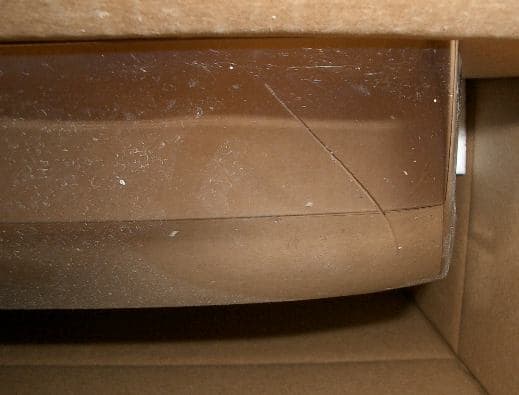
-----
"Worming" in chrome plated ABS - likely causes?
I've received warranty returns of chrome plated ABS automotive grilles that have raised tracks (about 1 mm high by 1 mm wide)in the finish running 2-3" in length. I've been told that they are caused by stones hitting the grille in cold weather (I can not see the alleged impact point). What would cause a single stone impact to propagate a failure in a linear fashion instead of just a localized blister? What are the most likely root causes of this defect? Is there some way of determining if a part will be suceptable to this failure (inspection)? Thanks

By the way is there some "trick" to digitally photographing chrome plating defects to avoid reflections of the surroundings in the surface? For this picture I put the part in a cardboard box, but it makes the finish look brown.
Gregg AverillProduct Designer - Detroit, MI, USA
April 7, 2008
|
|
Hi, Gregg. The trick to photographing chrome is to reflect a predictable pattern in it; traditionally this has been metal screening, but since the age of cheap large format computer printers, people have also been reflecting test patterns printed on white paper. This works very well for flat areas, but perhaps not so well for things of complex shape like bumpers.  Ted Mooney, P.E. Striving to live Aloha finishing.com - Pine Beach, New Jersey Ted is available for instant help or longer-term assistance. |
April 9, 2008
It is caused either by lack of adhesion to plastic substate. (Lack of etching.Or improper times there after in the preplating cycle) Or, failure between plated metals. If you lift the blistered plating, is there plastic showing? If plastic is showing, it is improper etch or preplate.
If you peel and see copper to nickel, or nickel to nickel, it is not preplate but delamination in electroplating. Delamination is too high brightener, loss of contact during plating, to name a couple that are obvious. Hope this helps. We chrome plate ABS every day, and thermo cycle it. You should not be seeing what you are recieving.
Regards,
Warren, Michigan, USA
This possibly looks like a hair or brush hair that has got on to the plastic. This could be either when the plastic is being plated or when it was being processed for electroless metal deposition Alternatively, the plastic could have been scratched with something after the activation stage of electroless deposition had been completed. This would remove the active metallising surface from the plastic, resulting in an area where no electroless metal will be deposited and hence when electrolytic chromium is applied, it will be over a non-conducting area, resulting in no actual adhesive deposition. This will result in an area of poor chromium adhesion and subsequent blistering or lifting

Trevor Crichton
R&D practical scientist
Chesham, Bucks, UK
April 30, 2008
Another possibility is a highly stressed plastic part or area in the part due to improper molding practices or improper part or mold design. Check for sink marks, heavy changes in cross section, ejector contact points or other possible causes of stress near the affected areas. G. Marrufo-Mexico
Guillermo MarrufoMonterrey, NL, Mexico
May 2, 2008
Q, A, or Comment on THIS thread -or- Start a NEW Thread
 it will pass.
it will pass.